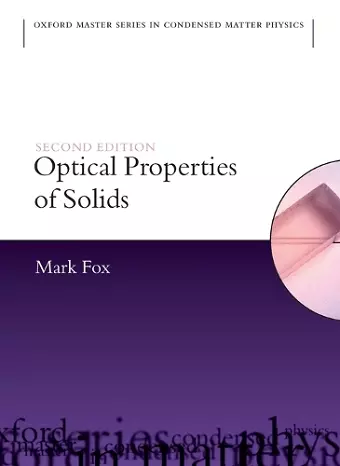Optical Properties of Solids
Format:Hardback
Publisher:Oxford University Press
Published:25th Mar '10
Currently unavailable, and unfortunately no date known when it will be back
This hardback is available in another edition too:
- Paperback£40.99was £40.99(9780199573370)

The second edition of this successful textbook provides an up-to-date account of the optical physics of solid state materials. The basic principles of absorption, reflection, luminescence, and light scattering are covered for a wide range of materials, including insulators, semiconductors and metals. The text starts with a review of classical optics, and then moves on to the treatment of optical transition rates by quantum theory. In addition to the traditional discussion of crystalline materials, glasses and molecular solids are also covered. The first edition included a number of subjects that are not normally covered in standard texts, notably semiconductor quantum wells, molecular materials, vibronic solid state lasers, and nonlinear optics. The basic structure of the second edition is unchanged, but all of the chapters have been updated and improved. Futhermore, a number of important new topics have been added, including: · Optical control of spin · Quantum dots · Plasmonics · Negative refraction · Carbon nanostructures (graphene, nanotubes and fullerenes) · NV centres in diamond The text is aimed at final year undergraduates, masters students and researchers. It is mainly written for physicists, but might also be useful for electrical engineers, materials scientists and physical chemists. The topics are written in a clear tutorial style with worked examples, chapter summaries and exercises. A solutions manual is available on request for instructors.
Easy to read and understand ... many examples which make it easier to understand. I can highly recommend this book * Michaela Kogler, University of Innsbruck *
This excellent book answers the questions of why and how the optical properties of solids differ from those of atoms. It is addressed to senior undergraduates, graduate students and researchers. The balance of physical explanation and mathematical description is very good. The text is supplemented by critical notes in the margins and integrated with self-explanatory figures. Several factors make this an excellent textbook. The problems with solutions augment the pedagogical value of the book, as do the chapter summaries, the further reading at the end of each chapter, the extensive and comprehensive appendices, the biography, the list of symbols and the index. * Barry R. Masters, OPN Optics & Photonics News 2011 *
ISBN: 9780199573363
Dimensions: 253mm x 195mm x 26mm
Weight: 1086g
416 pages
2nd Revised edition